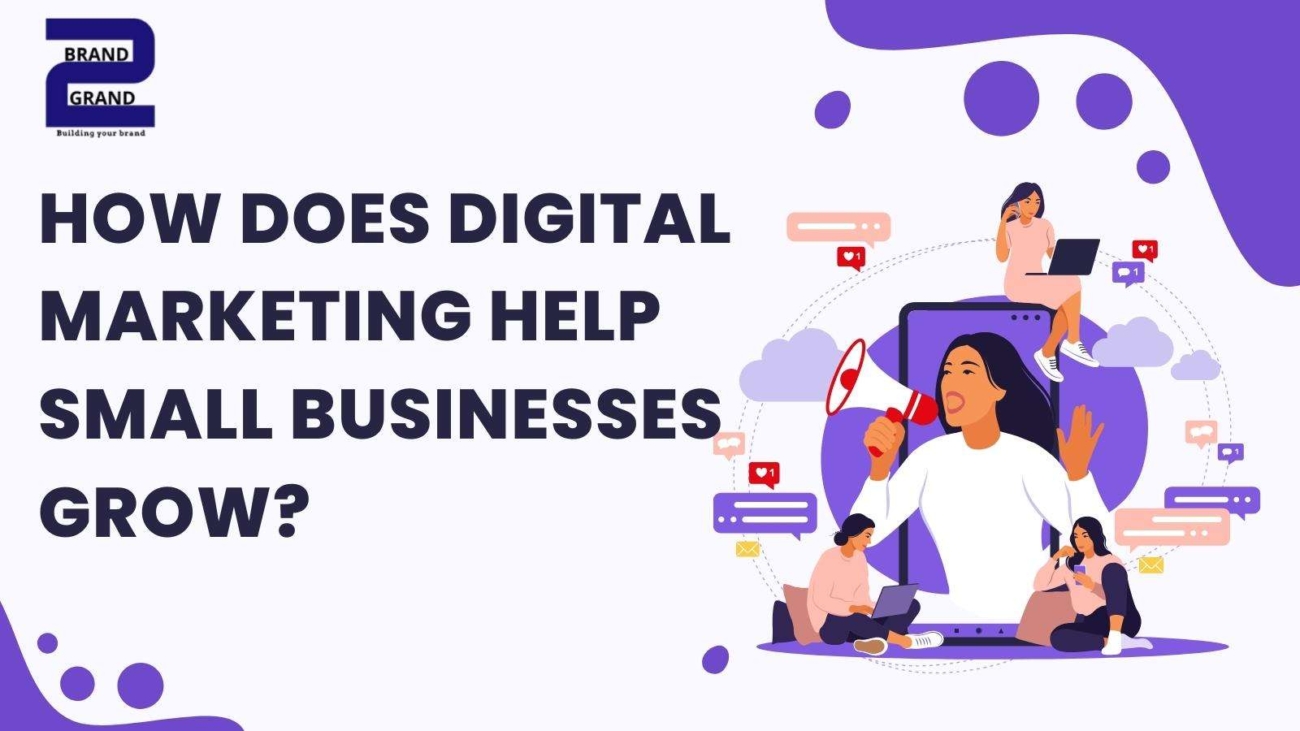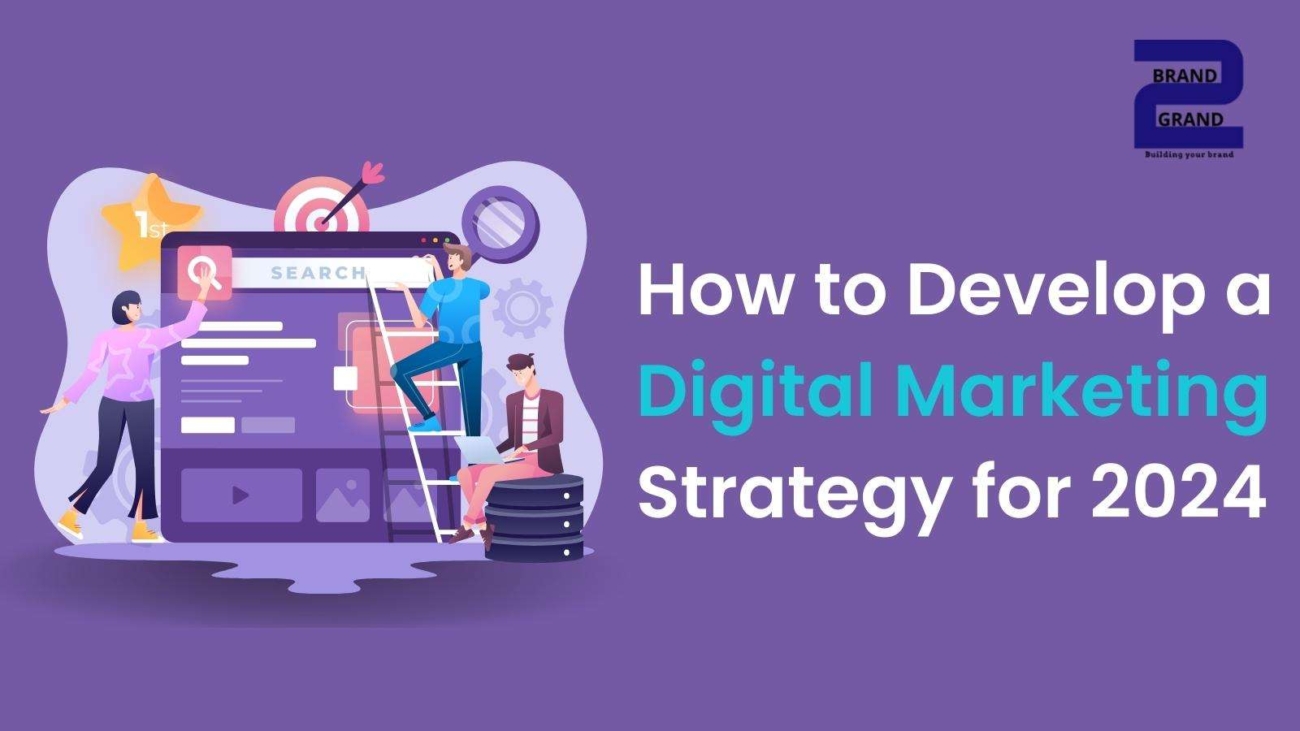Growing a business through digital marketing in 2024 will require a strategic and adaptable approach, given the evolving landscape. Here are key strategies to consider:
1. Understand Your Audience:-
– Conduct thorough audience research to understand their needs, preferences, and pain points.
– Create detailed buyer personas to tailor your digital marketing efforts effectively.
2. Quality Content Creation:-
– Invest in high-quality, relevant, and engaging content across various formats (text, video, audio, visuals).
– Consistently provide value to your audience to build trust and authority.
3. SEO Optimization:-
– Stay up-to-date with SEO best practices and algorithm changes.
– Focus on optimizing for voice and visual search.
– Use keyword research and on-page SEO to improve your website’s visibility in search results.
4. Personalization:-
– Leverage data and AI to deliver personalized experiences to your audience.
– Use dynamic content and tailored recommendations to engage users.
5. Mobile Optimization:-
– Ensure your website and content are mobile-friendly and load quickly.
– Optimize for mobile search, as mobile users are a significant portion of your audience.
6. Social Media Strategy:-
– Be present on the social media platforms where your audience is most active.
– Create engaging content, interact with your followers, and use paid advertising to expand your reach.
7. Email Marketing:-
– Develop a robust email marketing strategy to nurture leads and maintain customer relationships.
– Personalize email content and use automation for efficiency.
8. Video Marketing:-
– Invest in video content and live streaming.
– Use video to tell stories, demonstrate products, and connect with your audience.
9. Influencer Partnerships:-
– Collaborate with micro-influencers or industry experts to reach a wider audience.
– Ensure influencers align with your brand values and target demographics.
10. Data Analytics:-
– Use analytics tools to track the performance of your digital marketing efforts.
– Make data-driven decisions to optimize your strategies.
11. E-commerce Expansion:-
– If applicable, consider expanding your e-commerce capabilities to facilitate online sales.
– Implement an efficient and user-friendly online shopping experience.
12. Local SEO:-
– For businesses with physical locations, focus on local SEO strategies to attract nearby customers.
– Encourage customer reviews and ensure your Google My Business profile is up-to-date.
13. Sustainability and Social Responsibility:-
– Embrace sustainable and socially responsible practices and communicate them in your marketing efforts.
– Highlight your commitment to ethical and environmentally-friendly initiatives.
14. Adapt to Technological Changes:-
– Stay updated with emerging technologies like AR, VR, and blockchain that may impact your industry.
– Be ready to incorporate relevant technology into your marketing strategies.
15. Compliance and Ethics:-
– Stay compliant with data protection and privacy regulations.
– Be transparent in your data collection and usage practices.
16. Community Building:-
– Foster an online community around your brand.
– Engage with your audience on social media and encourage user-generated content.
17. Test and Experiment:-
– Continuously test and experiment with different digital marketing tactics.
– Be open to trying new channels and approaches as the digital landscape evolves.
18. Invest in Training and Talent:-
– Ensure your team has the necessary skills and knowledge to implement effective digital marketing strategies.
– Consider investing in ongoing training and hiring experts if needed.
Digital marketing in 2024 will be characterized by adaptability and a strong focus on providing value and personalized experiences to the audience. Keep an eye on industry trends, stay updated with best practices, and be ready to adjust your strategies as needed to achieve business growth in the digital space.
How does digital marketing help small businesses grow
Digital marketing can be a powerful tool for small businesses looking to grow and succeed in today’s digital age. Here are several ways in which digital marketing can benefit small businesses:
1. Cost-Effective:- Digital marketing is often more cost-effective than traditional marketing methods. Small businesses with limited budgets can reach a broader audience through online channels like social media, email marketing, and search engine optimization (SEO) without the high costs associated with print or TV advertising.
2. Targeted Audience:- Digital marketing allows businesses to target specific demographics and interests, ensuring that their message reaches the most relevant audience. This targeted approach increases the likelihood of conversion and customer engagement.
3. Online Visibility:- Having a strong online presence is crucial in today’s digital landscape. Digital marketing helps businesses establish and maintain their online visibility, making it easier for potential customers to find them through search engines, social media, and other online platforms.
4. Measurable Results:- Unlike traditional marketing, digital marketing provides detailed analytics and performance metrics. Small businesses can track the effectiveness of their campaigns in real-time, allowing them to make data-driven decisions and optimize their strategies.
5. Increased Customer Engagement:- Social media and email marketing enable direct interaction with customers. Small businesses can build relationships, gather feedback, and provide excellent customer service through these channels.
6. Global Reach:- Small businesses can reach a global audience, breaking geographical boundaries and expanding their customer base. This is especially beneficial for businesses looking to grow beyond their local market.
7. Content Marketing:- Creating valuable and relevant content is an essential part of digital marketing. Small businesses can use content to position themselves as industry experts, attract and engage customers, and build trust with their audience.
8. Competitive Advantage:- Digital marketing levels the playing field for small businesses, allowing them to compete with larger corporations. A well-executed digital strategy can help small businesses differentiate themselves in the market.
9. Flexibility:- Digital marketing strategies can be adapted and changed quickly to respond to market trends or adjust to shifting business needs. This agility is essential for small businesses looking to stay competitive.
10. Online Sales:- E-commerce and online marketplaces provide opportunities for small businesses to sell their products and services directly to customers, expanding their revenue streams.
11. Improved ROI:- With the ability to track and analyze campaign performance, small businesses can make data-driven decisions to maximize their return on investment (ROI).
To make the most of digital marketing, small businesses should carefully plan their strategies, understand their target audience, and stay updated with the latest digital marketing trends and technologies. Whether it’s through social media marketing, SEO, email campaigns, or paid advertising, a well-executed digital marketing plan can significantly contribute to a small business’s growth and success.
How to Develop a Digital Marketing Strategy for 2024
Developing a digital marketing strategy for 2024 requires a forward-thinking approach that incorporates the latest trends and technologies. Here’s a step-by-step guide to help you create an effective digital marketing strategy for the coming year:
1. Set Clear Objectives:-
– Define specific, measurable, achievable, relevant, and time-bound (SMART) goals for your digital marketing efforts. These goals could include increasing website traffic, growing social media followers, boosting sales, or improving brand awareness.
2. Audience Research:-
– Understand your target audience’s demographics, behaviors, interests, and pain points. Create detailed buyer personas to guide your marketing efforts effectively.
3. Competitive Analysis:-
– Analyze your competitors’ digital marketing strategies. Identify their strengths, weaknesses, and areas where you can differentiate your brand.
4. SWOT Analysis:-
– Conduct a SWOT (Strengths, Weaknesses, Opportunities, Threats) analysis for your business to identify internal and external factors that can impact your digital marketing strategy.
5. Budget Allocation:-
– Determine your digital marketing budget. Allocate funds to different channels and tactics, ensuring a balance that aligns with your objectives.
6. Channel Selection:-
– Identify the digital marketing channels that are most relevant to your audience and goals. This could include social media, email marketing, content marketing, SEO, paid advertising, and more.
7. Content Strategy:-
– Develop a content strategy that includes the type of content you’ll create (blog posts, videos, infographics, etc.), the topics you’ll cover, and a content calendar for consistent publishing.
8. Search Engine Optimization (SEO):-
– Optimize your website and content for search engines. Research keywords, improve site speed, and ensure mobile-friendliness.
9. Social Media Plan:-
– Create a social media strategy that outlines your posting schedule, content themes, and engagement tactics. Consider using paid social media advertising for increased reach.
10. Email Marketing:-
– Plan and segment your email marketing campaigns. Consider personalized emails and automation to nurture leads and maintain customer relationships.
11. Paid Advertising:-
– If relevant, set up paid advertising campaigns on platforms like Google Ads, Facebook Ads, or LinkedIn Ads. Create compelling ad copy and target specific demographics.
12. Conversion Funnel:-
– Map out the customer journey from awareness to conversion. Create content and touchpoints to guide potential customers through each stage.
13. Data and Analytics:-
– Implement analytics tools to measure the performance of your digital marketing efforts. Regularly analyze data to make data-driven decisions and optimize your strategy.
14. Adapt to Emerging Trends:-
– Stay informed about the latest digital marketing trends and technologies, such as AI, voice search, or augmented reality. Be ready to incorporate these into your strategy as they become relevant.
15. Community Building:-
– Engage with your audience and build an online community around your brand. Encourage user-generated content and foster a sense of belonging.
16. Testing and Optimization:-
– Continuously test and experiment with different tactics. Monitor the results, identify what works best, and adjust your strategy accordingly.
17. Sustainability and Social Responsibility:-
– Consider how sustainability and social responsibility initiatives can be integrated into your digital marketing efforts. Communicate your commitment to these principles.
18. Ethical Marketing:-
– Ensure that your digital marketing practices adhere to ethical standards, respecting data privacy and transparency.
19. Team and Training:-
– Invest in training and development for your digital marketing team. Ensure they have the skills and knowledge to execute your strategy effectively.
20. Review and Refine:-
– Regularly review your digital marketing strategy, assess its performance, and make necessary refinements to keep it aligned with your goals and the evolving digital landscape.
Remember that a successful digital marketing strategy for 2024 requires adaptability and a commitment to delivering value and personalized experiences to your audience. Stay flexible, monitor trends, and be prepared to adjust your strategy as needed to achieve your business objectives.
Why is video marketing important ?
Video marketing is important for several reasons, and it has become a valuable and effective tool for businesses and individuals alike. Here are some key reasons why video marketing is crucial:
1. Engagement:- Videos are highly engaging and can capture and retain the viewer’s attention more effectively than text or static images. They allow for a dynamic and interactive way to convey information, making it easier to connect with your audience emotionally.
2. Conveying Information:- Video can communicate complex information quickly and efficiently. It’s an ideal medium for explaining products, demonstrating how things work, and presenting concepts in an easily understandable format.
3. Improved SEO:- Search engines like Google often favor video content, and websites with video are more likely to rank higher in search results. This can increase your online visibility and drive more organic traffic to your website.
4. Social Media Visibility:- Social media platforms are highly conducive to video sharing. Videos tend to get more likes, shares, and comments, which can help increase your brand’s visibility and engagement on social media.
5. Building Trust:- Videos allow you to put a face to your brand. By showcasing real people, whether it’s the founder, employees, or customers, you can build trust and a more personal connection with your audience.
6. Storytelling:- Video is an excellent medium for storytelling. It allows you to create narratives that resonate with your audience, convey your brand’s message, and evoke emotions. Storytelling is a powerful tool for brand building.
7. Mobile Compatibility:- With the proliferation of smartphones and mobile devices, video content is easily accessible to a large and growing mobile audience. This is essential for reaching people on the go.
8. Diversification:- Video marketing diversifies your content strategy. By including videos alongside text-based content, infographics, and images, you cater to different audience preferences and learning styles.
9. Shareability:- Videos are highly shareable, and social media users are more likely to share videos with their networks. This viral potential can significantly expand your reach.
10. Measurable Results:- Video marketing provides detailed analytics, allowing you to track how your videos are performing. You can measure engagement, view counts, click-through rates, and more to understand what’s working and what needs improvement.
11. Competitive Advantage:- As video marketing becomes more prevalent, businesses that embrace it have a competitive advantage. It allows you to stand out in a crowded digital landscape.
12. Customer Education:- Videos can educate customers about your products and services, answer frequently asked questions, and provide how-to guides. This can enhance the customer experience and reduce support inquiries.
13. Lead Generation:- Video content can be a powerful tool for generating leads. By creating compelling videos that capture viewer information through forms or calls to action, you can grow your email list and customer base.
In summary, video marketing is essential because it offers a dynamic, engaging, and efficient way to reach and connect with your target audience, improve your online visibility, and build trust and credibility. It’s a versatile tool that can benefit businesses and individuals across various industries and goals.
6 Digital Marketing Trends to Watch Out For in 2024
Digital marketing is a dynamic field, and it’s important to stay ahead of the latest trends to remain competitive and effective. Here are six digital marketing trends to watch out for in 2024:
1. AI-Powered Marketing:-
Artificial Intelligence (AI) and machine learning are set to play an even larger role in digital marketing. AI can analyze vast amounts of data to provide insights, optimize ad campaigns, personalize content, and enhance the customer experience. Chatbots and virtual assistants are also becoming more sophisticated, offering better customer support and engagement.
2. Voice Search Optimization:-
With the increasing popularity of voice-activated devices like smart speakers and virtual assistants, optimizing for voice search is critical. Marketers will need to adapt their SEO strategies to accommodate natural language queries, long-tail keywords, and provide concise, informative answers.
3. Privacy and Data Protection:-
Concerns over data privacy and regulations like GDPR and CCPA are driving changes in digital marketing. Marketers will need to focus on transparent data collection, consent-based marketing, and responsible handling of customer information. Privacy-centric digital advertising strategies will become more prevalent.
4. Video Dominance:-
Video content continues to be a dominant force in digital marketing. Short-form videos, live streams, and interactive video content will be key for engaging audiences. Video SEO and shoppable videos are likely to gain prominence as well.
5. Augmented and Virtual Reality (AR/VR):-
AR and VR technologies are evolving rapidly, offering new opportunities for digital marketing. Brands can create immersive experiences, such as virtual showrooms, try-before-you-buy AR applications, and interactive advertising campaigns to engage and convert customers.
6. Sustainability and Social Responsibility:-
Consumers are increasingly conscious of environmental and social issues. Brands that embrace sustainability and social responsibility in their digital marketing efforts will likely see increased trust and loyalty. This includes highlighting eco-friendly practices, supporting social causes, and adopting ethical advertising practices.
In addition to these trends, it’s important to stay updated on shifts in social media algorithms, emerging platforms, and changes in consumer behavior. Successful digital marketing in 2024 will require agility, adaptability, and a focus on creating meaningful and relevant experiences for the target audience.
Marketing vs Advertising: Everything You Need To Know
Marketing and advertising are two essential components of a company’s overall strategy to reach and engage with its target audience. While they are often used interchangeably, they represent distinct aspects of promoting a product or service. Understanding the differences and how they work together is crucial for any business aiming to succeed in today’s competitive market. In this article, we’ll explore the key differences between marketing and advertising and their respective roles in a company’s success.
1. Definition:-
– **Marketing:** Marketing is a broader concept that encompasses a set of strategies and activities focused on promoting a product, service, or brand. It involves understanding the target market, creating a value proposition, determining pricing, identifying distribution channels, and designing strategies to communicate with customers effectively.
– **Advertising:** Advertising is a subset of marketing that involves the creation and dissemination of promotional messages through various channels like print, digital, TV, radio, and social media. It’s a specific form of communication intended to influence the behavior and decisions of a target audience.
2. Scope:-
– **Marketing:** Marketing is a holistic approach that covers market research, product development, pricing strategies, distribution channels, branding, public relations, and customer engagement. It focuses on the overall perception of the brand in the market.
– **Advertising:** Advertising is a narrower aspect of marketing and concentrates specifically on the creation and distribution of persuasive messages to generate interest and drive sales.
3. Objectives:-
– **Marketing:** The primary goal of marketing is to create value for customers, build strong brand awareness, establish customer loyalty, and ultimately drive sales and revenue growth.
– **Advertising:** Advertising aims to capture attention, raise awareness about a product or service, generate interest, and persuade customers to take a specific action, such as making a purchase.
4. Strategies:-
– **Marketing:** Marketing strategies involve market segmentation, target audience analysis, product positioning, market research, and the development of the marketing mix (product, price, place, promotion).
– **Advertising:** Advertising strategies revolve around choosing the right advertising channels, determining the message, creating compelling visuals and copy, setting a budget, and measuring the effectiveness of ad campaigns.
5. Duration:-
– **Marketing:** Marketing is a continuous, long-term effort that involves building and maintaining relationships with customers over an extended period.
– **Advertising:** Advertising campaigns are typically time-bound and can range from short-term, intensive campaigns to ongoing, consistent advertising efforts.
6. Communication:-
– **Marketing:** Marketing communication involves all the touchpoints a customer has with a brand, including advertising, public relations, direct marketing, sales promotions, and more.
– **Advertising:** Advertising is a specific tool used for communication within the broader marketing strategy.
7. Cost and Resources:-
– **Marketing:** Marketing involves a comprehensive allocation of resources, including financial, human, and time resources, to execute various strategies and tactics effectively.
– **Advertising:** Advertising represents a portion of the overall marketing budget, focusing on paid promotional activities.
8. Measurement:-
– **Marketing:** Measuring the success of marketing efforts involves analyzing overall brand health, customer satisfaction, customer retention rates, sales growth, and market share.
– **Advertising:** Advertising success is measured through metrics like reach, impressions, click-through rates (CTR), conversion rates, return on ad spend (ROAS), and other specific advertising-related KPIs.
Conclusion: In summary, marketing is a comprehensive strategy that encompasses all activities related to promoting a product or service, while advertising is a specific component within the larger marketing framework. Both are crucial for a business’s success, and understanding their differences and integration is essential to create effective and impactful promotional campaigns. A well-rounded marketing strategy that leverages the power of advertising can help businesses reach their target audience, generate leads, and drive revenue growth.
How to Rank Your Website on ChatGPT
Ranking your website on search engines like Google is crucial for increasing visibility, attracting organic traffic, and achieving your online goals. While ChatGPT itself does not directly influence website rankings, it can provide valuable information and guidance to help you optimize your website for search engine optimization (SEO). Here’s how to rank your website with the help of ChatGPT:
1. Understand SEO Fundamentals:-
Begin by gaining a solid understanding of SEO principles. SEO is a multifaceted strategy involving keyword research, on-page optimization, technical SEO, content creation, and link building. ChatGPT can provide explanations and insights into these concepts.
2. Keyword Research:-
Use ChatGPT to generate ideas for relevant keywords and phrases related to your website’s content. Incorporate these keywords naturally into your website’s content, titles, headings, and metadescriptions. Tools like Google Keyword Planner can help you identify high-traffic, low-competition keywords.
3. Content Creation:-
High-quality, relevant content is a key factor in SEO. ChatGPT can assist in brainstorming content ideas, generating blog post topics, and helping you create engaging and informative content. Aim for comprehensive, well-researched articles that provide value to your target audience.
4. On-Page Optimization:-
Ensure your website is well-optimized for search engines. This includes optimizing meta titles and descriptions, using header tags (H1, H2, etc.), and optimizing images. ChatGPT can help you understand the best practices for on-page SEO.
5. Technical SEO:-
Technical aspects of your website, such as page speed, mobile-friendliness, and website structure, are crucial for SEO. ChatGPT can provide guidance on improving technical aspects or suggest tools and plugins that can help.
6. Link Building:-
Building high-quality backlinks from authoritative websites is an essential part of SEO. ChatGPT can help you brainstorm link-building strategies, outreach email templates, and ideas for creating shareable content that attracts backlinks.
7. User Experience (UX):-
A positive user experience is critical for SEO. Ensure your website is easy to navigate, loads quickly, and is mobile-responsive. ChatGPT can provide recommendations on improving the UX based on user feedback and best practices.
8. Local SEO (if applicable):-
If you have a local business, ChatGPT can offer insights into optimizing your website for local search. This includes setting up and optimizing your Google My Business listing and encouraging customer reviews.
9. Monitoring and Analysis:-
Regularly monitor your website’s performance using tools like Google Analytics and Google Search Console. ChatGPT can help you understand the data and metrics, such as organic traffic, click-through rates, and bounce rates, and suggest adjustments based on the results.
10. Stay Informed and Adapt:-
SEO is an ever-evolving field. ChatGPT can help you stay informed about algorithm updates and industry trends. Being adaptable and open to adjusting your strategies based on new information is essential for long-term SEO success.
Remember that SEO is a long-term strategy, and it may take time to see significant results. Consistency and a commitment to providing valuable content and a great user experience are key to improving your website’s ranking over time. While ChatGPT can provide valuable insights and guidance, it’s essential to combine its assistance with your own efforts and continuous learning in the field of SEO.







